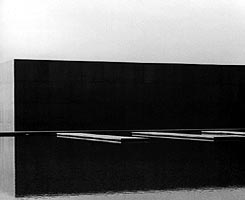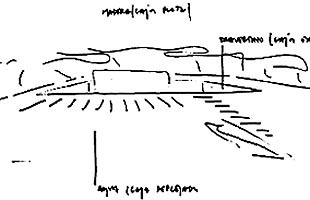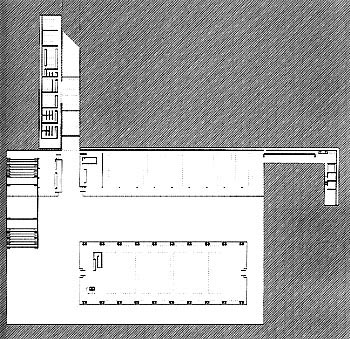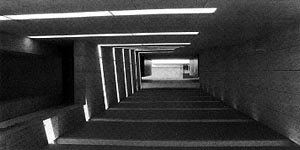Alfredo Payá



| MUA | Museo
Universitario de Alicante |
Universitary museum in Alicante |
| Arquitecto/ Architect: Alfredo Payá
|
|
 |
El proyecto plantea la ocupación de la
parcela mediante una lámina de AGUA, sólo interrumpida por un gran
vacío del que emerge una gran CAJA de madera que flota en éste y que se
nos muestra inaccesible. En la imagen del Campus Universitario —una gran
extensión verde poblada de arbolado y salpicada de edificación ordenada
según una trama—, el estanque aparecerá reflejando en sus aguas la
"caja" envuelta en la masa de árboles como ocurre con los
pabellones de tantos jardines.
El PATIO se configura como elemento que articula las diferentes partes
del museo, constituyendo a su vez un LUGAR apropiado para la meditación y
el reposo. Desde este espacio, podremos acceder a todas las piezas del
edificio: las salas del museo polivalente, el auditorio al aire libre, la
sala cubierta y, por supuesto, al gran protagonista del proyecto: la CAJA. Estas cuatro piezas, desarrolladas en una sola planta, constituyen dos
parejas que dialogan dos a dos, por un tanto los museos a través de sus
espacios de circulación y, por otro los auditorios que enfrentados tienen
la posibilidad de incorporarse uno al otro, la sala cubierta está dotada
de un mecanismo que permite al frente de la escena plegarse de forma que
las dos salas se integren. Todo el museo se desarrolla deprimido sobre la cota del terreno,
creando un espacio tranquilo y resolviendo la perturbación que el ruido
de la autovía pudiera producir (además se plantará una tupida masa de
arbolado para reforzar este efecto). La LUZ CENITAL, por un lado, y la LUZ REFLEJADA en las aguas por otro,
contribuirán a crear una atmósfera adecuada para la contemplación, la
relajación y la quietud. La "CAJA", es decir, el espacio que albergará la colección
permanente, protagonista principal del conjunto, se ha planteado como una
pieza de gran altura, flotante e ingrávida, con una pequeña rasgadura en
su parte baja de forma que existe una total permeabilidad con el patio. La
volumetría de la caja y el tratamiento de la luz serán responsables de
una cierta sensación de infinidad. Sus gruesos muros, compuestos de doble
hoja, permiten alojar en su interior las instalaciones del edificio, así
como los elementos audiovisuales. Proyectores, pantallas, vídeo,... produciéndose de este modo un espacio interactivo. |
The project plans to cover the site with a sheet of
WATER that is interrupted only by a great EMPTY SPACE from which a great
wooden BOX emerges, floating in it, apparently INACCESSIBLE. In the image
of the university campus —a large expanse of green space covered in
trees and doted with buildings in an orderly layout— the waters of the
pool will reflect the "box", enveloped in a mass of trees, in
the same way as pavilions are reflected in so many gardens.
The PATIO is the element that articulates the different parts of the
Museum while also forming an agreeable PLACE for meditation and repose.
Every part of the building can be reached from here: the rooms of the
multi-purpose museum, the open-air auditorium, the covered hall and, of
course, the great centre piece of the project, the BOX. These four pieces on a single ground plan define two parallels that
talk to each other two by two. On the one hand, the museums communicate
through their circulation spaces, on the other, the auditoriums, face to
face, can be integrated into each other, as the front of the covered hall’s
stage can be folded away in order to join the two together. The entire Museum lies in a hollow in the ground, creating a quiet
space and providing a solution to the possible annoyance of noise from the
motorway (and a thick screen of trees will be planted to reinforce this
effect). The ZENITHAL LIGHT, on the one hand, and the REFLECTED LIGHT from the
water, on the other, will help to create a suitable atmosphere for
contemplation, relaxation and quietude. The "box", the space that will house the permanent
collection, is the start of the ensemble. The idea is a very high block,
floating, weightless, with a small scratch at its lower end so that there
is total permeability with the patio. The volume of the box and the
treatment of the light will give a certain impression of infinity. The
cavity between its thick double walls houses the piping and wiring as well
as the audio-visual elements such as projectors, screens, videos, etc.,
thus constituting an interactive space. |

|
 |
 |
 |
|
| Traducción al inglés/English translation:Gina Hardinge. |